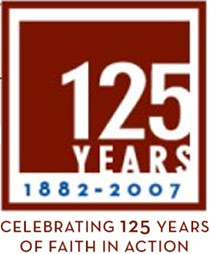Monstrance
 Chalice
ChaliceCiborium
Paten
Pyx
The terms monstrance and ostensorium (both of which refer to the same device) were originally applied to any preciously wrought container in which glass or crystal was employed to allow the contents to be seen from the outside. Modern English usage, however, limits the terms to only those made for displaying the Blessed Sacrament.
The origins of the monstrance are poorly known. Obviously, no need for the vessel existed before the popularization of Eucharistic processions and adorations. This fact leads scholars to date the introduction of the first true ostentoria to the 13th century. Records exist of the Blessed Sacrament being carried in procession back to the early 11th century, but not in a visible fashion. At that time the Eucharist was placed in an ornate box or ark, or simply in a ciborium, for these purposes.
It seems that the monstrance itself developed not out of the arks and boxes,
 but out of the ciboria. By placing a glass or crystal cylinder in the cup of the ciborium, and replacing the lid on top of this, the vessel was elongated and enlarged, and could serve either to display the Sacred Host in procession or hold them while dispensing Holy Communion. Soon, however, the practice of Eucharistic exposition grew to such popularity that it was necessary to have vessels for just this purpose. The glass cylinders were retained initially, and soon they acquired embellishments and supports resembling the columns, spires, arches, and statuary of churches. The large host was held in the cylinder by a lunette. This style of decoration can still be seen to a certain extent in gothic monstrances (seen at right).
but out of the ciboria. By placing a glass or crystal cylinder in the cup of the ciborium, and replacing the lid on top of this, the vessel was elongated and enlarged, and could serve either to display the Sacred Host in procession or hold them while dispensing Holy Communion. Soon, however, the practice of Eucharistic exposition grew to such popularity that it was necessary to have vessels for just this purpose. The glass cylinders were retained initially, and soon they acquired embellishments and supports resembling the columns, spires, arches, and statuary of churches. The large host was held in the cylinder by a lunette. This style of decoration can still be seen to a certain extent in gothic monstrances (seen at right).By the fifteenth century certain shortcomings of these ostensoria had been observed, and there was a general redesign of the vessel. This reduced the transparent part of the vessel to the small host-sized opening found today and introduced the practice of surrounding the host with emanating rays. This is the monstrance we see most commonly today. The alteration in design was motivated by a desire to focus attention more centrally on the Blessed Sacrament itself, which was more difficult in the tall vessels with lots of glass.
A variety of unusual ostensoria were used at one point or another throughout Europe. The English, in the late middle ages, built them in the shape of Christ Himself, and placed the Sacred Host in a glass chamber in the statue's chest. In the sixteenth century a continental habit developed, especially in Spain, of constructing inordinately large monstrances. There monstrances weighing hundreds of pounds and standing six or more feet were built. The great monstrance of the cathedral of Toledo took 100 years to build and stands over 12 feet high.
The orb and rays of a monstrance should be made, at the very least, of silver (or silver plated). The entire device should be surmounted by a cross. If the Sacred Host is to be displayed between glass (as is more practical, so as to prevent its falling during benedictions), then it should be constructed so that the host does not touch the glass. Thus, a modified form of the lunette (so called because of its crescent shape) is still used in modern monstrances. In most instances, the host is placed in a detachable glass pyx called a custodia.
File Under: Sacred_Vessels








1 Comments:
I think monstrances are extremely beautiful. I love them especially since they look so much like the sun - Jesus Christ is the Light of the World.
I think it was St. Clare that was pictured with a monstrance, and I frequently think of the Eucharist in the monstrance.
Post a Comment
<< Home